ISSN ONLINE(2278-8875) PRINT (2320-3765)
ISSN ONLINE(2278-8875) PRINT (2320-3765)
M.Bharathi1, C.Selvakumar2
|
| Related article at Pubmed, Scholar Google |
Visit for more related articles at International Journal of Advanced Research in Electrical, Electronics and Instrumentation Engineering
Designing control systems for complete plants is the ultimate goal of a control designer. The problem is quite large and complex. It involves a large number of theoretical and practical considerations such as quality of controlled response; stability; the safety of the operating plant; the reliability of the control system; the range of control and ease of startup, shutdown, or changeover; the ease of operation; and the cost of the control system. The difficulties are aggravated by the fact that most of the industrial and chemical processes are largely nonlinear, imprecisely known, multivariable systems with many interactions. The measurements and manipulations are limited to a relatively small number of variables, while the control objectives may not be clearly stated or even known at the beginning of the control system design. Thus, the presence of process input-output time delay of different magnitude in multi-input-multi-output systems have drawn attention to research as the processes are difficult to control. Increase in complexity and interactions between inputs and outputs yield degraded process behavior. Such processes are found only in process industries as they arise from the design of plants that are subject to rigid product quality specifications, are more energy efficient, have more material integration, and have better environmental performance. Multivariable systems contain more than one controlled variable (outputs) or manipulated variables (inputs). Thus the control of these MIMO systems plays a major role and has been interesting various engineers in the recent years. In process control industries, more than 95% of the control loops are of PI/PID type. This is mainly attributed to its effectiveness and relatively simple structure, which can be easily understood and implemented in practice. Consequently, the research on PID control algorithm development and their applications is still a very active area; many formulas have been derived to tune the PID controllers over the years. For easier field implementation, it is desirable to apply well established single loop PID tuning principles to the MIMO processes. However, compared with single-input single single-output (SISO) counterparts, MIMO systems are more difficult to control due to the existence of interactions between input and output variables. Adjusting controller parameters of one loop affects the performance of the others, sometimes to the extent of destabilizing the entire system. To ensure stability, many industrial controllers are tuned loosely, which causes inefficient operation and higher energy costs. Thus, an efficient design methodology which ensures both the plant stability as well as the increased productivity is the need of the hour.
OBJECTIVE |
||||||||||||||
| In recent years all the methodologies adapted to solve for the parameters of individual controllers in which the loop interactions are taken into account have not guaranteed a solution. In addition, the extension for higher dimensional systems seems difficult because of the complicated and non-linear computation. It has been found that the independent design of decentralized controllers based on model based method is simple and effective only for low dimensional processes. For high dimensional processes this design has to be more conservative due to the inevitable modeling errors encountered in formulation. | ||||||||||||||
| To overcome all these drawbacks and to include interactions in the control design, a novel method based on the equivalent transfer function method (ETF) is proposed. By considering four combination modes of gain and phase changes for a particular loop when all other loops are closed, this equivalent transfer function can effectively approximate the dynamic interactions among loops. Consequently, the design of decentralized controller for MIMO processes can be converted to the design of single loop controllers. The method is simple, straightforward, easy to understand and implement. Several multivariable industrial processes with different interaction characteristics are employed to demonstrate the effectiveness and simplicity of the design method compared to the existing methods. | ||||||||||||||
CONTROLLER DESIGN FOR MULTIVARIABLE SYSTEMS |
||||||||||||||
| The presence of multiple controlled outputs and multiple manipulated inputs creates a situation that offers more than one possible control configuration for a MIMO process. But the development of the more concise method which is feasible for all processes is more important. | ||||||||||||||
CONTROLLER DESIGN METHODOLOGIES |
||||||||||||||
| There are three major controller designs that are available. They are mainly | ||||||||||||||
| a) Centralized controller | ||||||||||||||
| b) Decentralized controller and | ||||||||||||||
| c) Decoupler | ||||||||||||||
| Of all the three configurations discussed above, the centralized controller is not used very widely because of the complexity and time constraints in computation. In addition to it the design is less transparent and can be damaging the entire plant during failures, thus not being highly reliable. The figure below shows the block diagram of a decentralized controller and with its representation. | ||||||||||||||
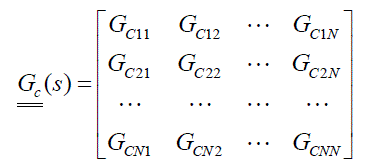 |
||||||||||||||
| The decoupler though profitable and realistic is also very complex and degrades the load rejection. It has to be applied carefully and is often recommended only for the servo operations. The Figure 2 shows the block diagram for the decoupler. | ||||||||||||||
| The Decentralized controllers are widely used because of their simplicity in hardware, design and tuning simplicity, flexibility in operation and maintenance. The block diagram of the decentralized controller is shown in figure 3. The decentralized controller is represented as | ||||||||||||||
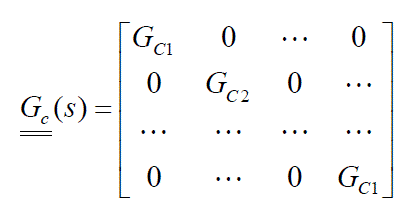 |
||||||||||||||
| All the three controller configurations are being shown for a 2x2 system with interactions. The decentralized controllers consist of multi loop SISO controllers with one control variable paired with one manipulated variable. The major idea in this design approach is that the SISO controllers should be tuned simultaneously with the interactions in the process taken into account. | ||||||||||||||
FOR DECENTRALISED CONTROLLER DESIGN |
||||||||||||||
| Most industrial control systems use the multi loop SISO diagonal control structure. It is the most simple and understandable structure. Operators and plant engineers can use it and modify it when necessary. It does not require an expert in applied mathematics to design and maintain it. In addition, the performance of these diagonal controller structures is usually quite adequate for process control applications. In fact, there has been little quantitative unbiased data showing that the performances of the more sophisticated controller structures are really any better! The slight improvement is seldom worth the price of the additional complexity and engineering cost of implementation and maintenance. | ||||||||||||||
| A number of critical questions must be answered in developing a control system for a plant. What should be controlled? What should be manipulated? How should the controlled and manipulated variables be paired in a multivariable plant? How do we tune the controllers? It was developed to provide a workable, stable, simple SISO system with only a modest amount of engineering effort. The resulting diagonal controller can then serve as a realistic benchmark, against which the more complex multivariable controller structures can be compared. The limitations of the procedure should be pointed out. It does not apply to open loop-unstable systems. It also does not work well when the time constants of the transfer functions are quite different, i.e., some parts much faster than others. | ||||||||||||||
| The fast and slow sections should be designed separately in such a case. The procedure has been tested primarily on realistic distillation column models. | ||||||||||||||
| This choice was deliberate because most industrial processes have similar gain, dead time, and lag transfer functions. Undoubtedly, some pathological transfer functions can be found that the procedure cannot handle. | ||||||||||||||
| The steps in the procedure are summarized below. | ||||||||||||||
| 1. Select controlled variables. Use primarily engineering judgment based on process understanding. | ||||||||||||||
| 2. Select manipulated variables. Find the set of manipulated variables that gives the largest minimum singular value of the steady-state gain matrix. | ||||||||||||||
| 3. Eliminate unworkable variable pairings. The pairing can be done with RGA ERGA or using NI indices. | ||||||||||||||
| 4. Find the best pairing from the remaining sets. | ||||||||||||||
| a. Tune all combinations using a efficient tuning methodology. | ||||||||||||||
| b. Select the pairing that gives the lowest-magnitude closed loop regulator transfer function. | ||||||||||||||
COMPUTATION OF EFFECTIVE TRANSFER FUNCTION |
||||||||||||||
| Consider an open loop stable multivariable system within inputs and n outputs as shown in Fig. 1, where are the reference inputs; are the manipulated variables are the system. Outputs, G(s) and are process transfer function matrixAnd decentralized controller matrix with compatible dimensions, expressed by | ||||||||||||||
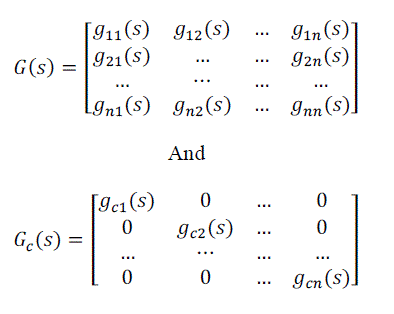 |
||||||||||||||
| respectively. | ||||||||||||||
| Let gij(jw)=kij goij(jw) | ||||||||||||||
| Where kijand gij ,are steady state gain and normalized transfer function of gij(jw),i.e., goij(0) = 1 , respectively. The interaction among individual loop is described by ERGA, the main result of ERGA is summarized as follows. | ||||||||||||||
 |
||||||||||||||
| where for i,j = 1,2,. . . ,n are the critical frequency of the transfer function and is the absolute value of . In order to calculate , the critical frequency can be defined in two ways: | ||||||||||||||
 |
||||||||||||||
 |
||||||||||||||
| For transfer function matrices with some elements without phase crossover frequencies, such as first order or second order without time delay, it is necessary to use corresponding bandwidths as critical frequencies to calculate .However, it is worth to point out that the phase crossover frequency information, i.e., ultimate frequency is recommended if applicable for calculation of , since it is closely linked to system dynamic performance and control system design. Without loss of generality, we will use as the bases for the following development. | ||||||||||||||
| For the frequency response of as shown in Fig. 5, is the area covered by up to . Since represents the magnitude of the transfer function at various frequencies, is considered to be the energy transmission ratio from the manipulated variable to the controlled variable . Express the energy transmission ratio array as | ||||||||||||||
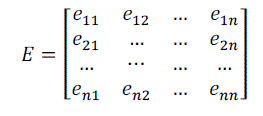 |
||||||||||||||
| To simplify the calculations, we approximate the integration of eij by a rectangle area, i.e., | ||||||||||||||
| Then, the effective energy transmission ratio array is given as: | ||||||||||||||
DECENTRALISED CONTROL SYSTEM DESIGN |
||||||||||||||
| Without loss of generality, we assume that each main loop, i.e., diagonal element in the transfer function matrix is represented by a second order plus dead time (SOPDT) model, which can be used to describe most of the industrial processes: | ||||||||||||||
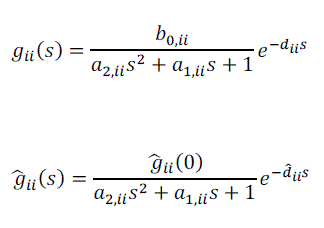 |
||||||||||||||
| Similarly, ETF is represented as, | ||||||||||||||
| The decentralized controllers can then be independently designed by single loop approaches based on the corresponding ETFs. Here we employ the gain and phase margins approach. This is primary because the frequency response method provides good performance in the face of uncertainty in both plant model and disturbances. The PID controller of each loop is supposed of the following standard form: | ||||||||||||||
 |
||||||||||||||
| The controller can be rewritten as | ||||||||||||||
 |
||||||||||||||
 |
||||||||||||||
| Denoting the gain and phase margin specifications as and and their crossover frequencies as and , , respectively, we have | ||||||||||||||
 |
||||||||||||||
| By substitution and simplification to above equations, we obtain | ||||||||||||||
 |
||||||||||||||
| Which results | ||||||||||||||
 |
||||||||||||||
| By this formulation, the gain and phase margins are interrelated to each other, some possible gain and phase margin selections are given in Table 1. | ||||||||||||||
| The PID parameters are given by | ||||||||||||||
 |
||||||||||||||
| Applying Eq. (8) for each case discussed in Section 3, we can easily obtain both ETFs and the PID parameters which are summarized in Table 2. | ||||||||||||||
| It can be seen that the proposed method results in better performance with a lesser value of peak overshoot and minimized oscillations. | ||||||||||||||
Example 2: |
||||||||||||||
| Consider an industrial-scale polymerization reactor given by | ||||||||||||||
 |
||||||||||||||
| The time scales are in hours, so it is a quite slow process. In addition, it is easy to verify that it is not diagonally dominant. The RGA, ERGA, CFA and RFA are computed and shown below. | ||||||||||||||
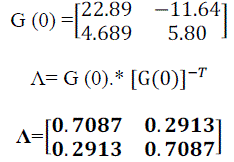 |
||||||||||||||
| The Critical Frequency Array is computed by determining the cross over frequency for the transfer functions describing the process. The cross over frequency for is found to be 8.0554 from the following figure [12]. The same procedure is performed for each element in G(s) to determine the CFA. | ||||||||||||||
| Thus the CFA is given as | ||||||||||||||
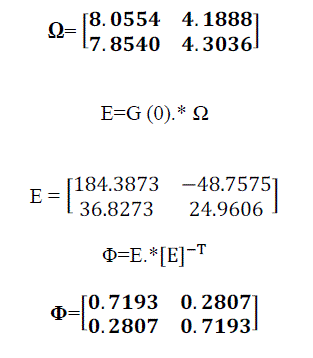 |
||||||||||||||
| The Relative Frequency Array can be obtained by performing the Hadamard division of ERGA by RGA. The RFA was found to be, | ||||||||||||||
 |
||||||||||||||
| Both ERGA and RGA indicate diagonal pairing. This process falls under the case 2 and according to ETF method the equivalent process for the two loops are calculated as | ||||||||||||||
 |
||||||||||||||
| The PI controllers are determined with the proposed method and the response is compared with ETF method, RGA based tuning approach by Chien et al, BLT tuning approach by Luyben and the relay based auto-tuning approach proposed by Loh et al. The controller values computed are tabulated below. | ||||||||||||||
| The peak overshoot is fairly reduced in the proposed method with minimized oscillations and a better settling time. | ||||||||||||||
CONCLUSION |
||||||||||||||
| Effective transfer function approach is a novel method for decentralized control system design of multivariable interactive processes. An extension of the effective transfer function approach by taking into consideration all the interactions was proposed and implemented successfully with improved responses. The simplicity and effectiveness of the method is based on the incorporation of the interaction frequency directly in the controller design. This approach ensures that all the necessary information of the gain and interaction frequency changes are provided. The decentralized controllers are obtained by simply using the single loop design approaches. Simulation results for the four 2x2 processes and a 3x3 process show that the proposed method provides a better overall performance compared to the other design approaches even after taking into account the interactions. The advantage of this method is more significant when applied to higher dimensional processes with complicated interaction modes. Since this is an extension of the ETF approach, it can also be easily integrated into an auto-tuning control structure. This method can also be successfully tested for the other MIMO processes. Also employment of BLT tuning after obtaining the effective transfer function can also be performed for better results. | ||||||||||||||
Tables at a glance |
||||||||||||||
|
||||||||||||||
Figures at a glance |
||||||||||||||
|
||||||||||||||
References |
||||||||||||||
|